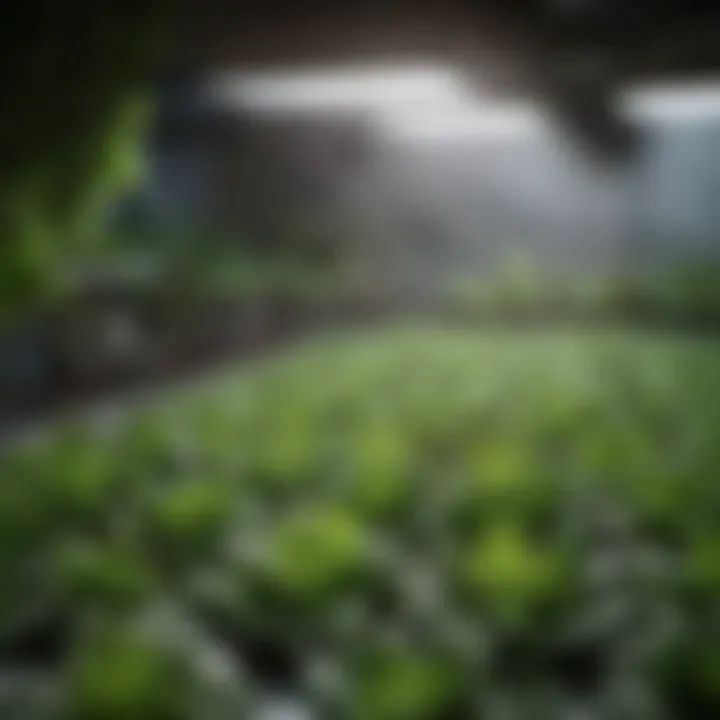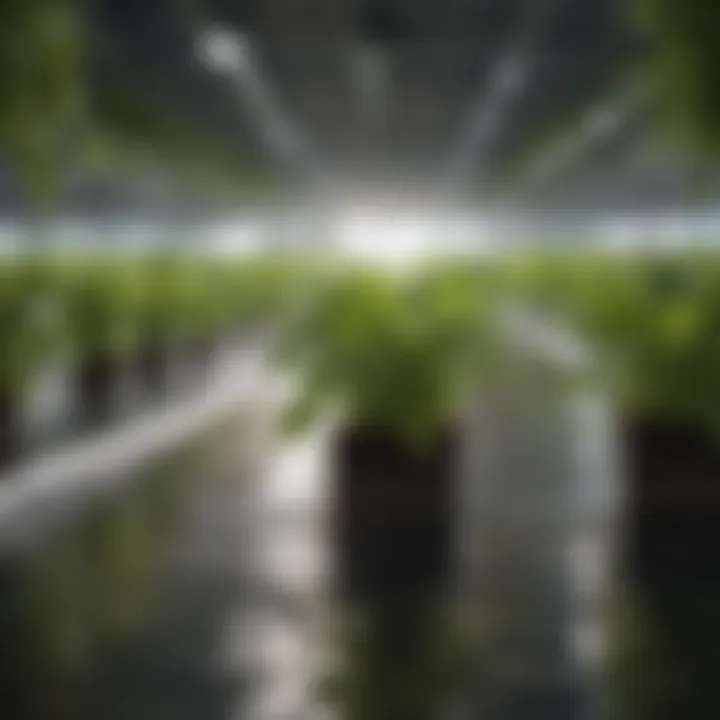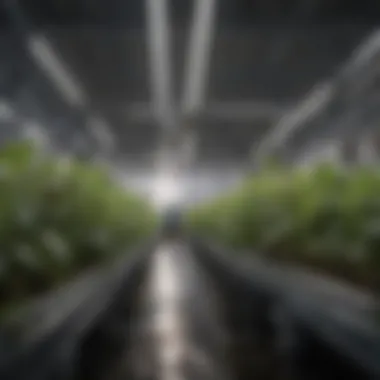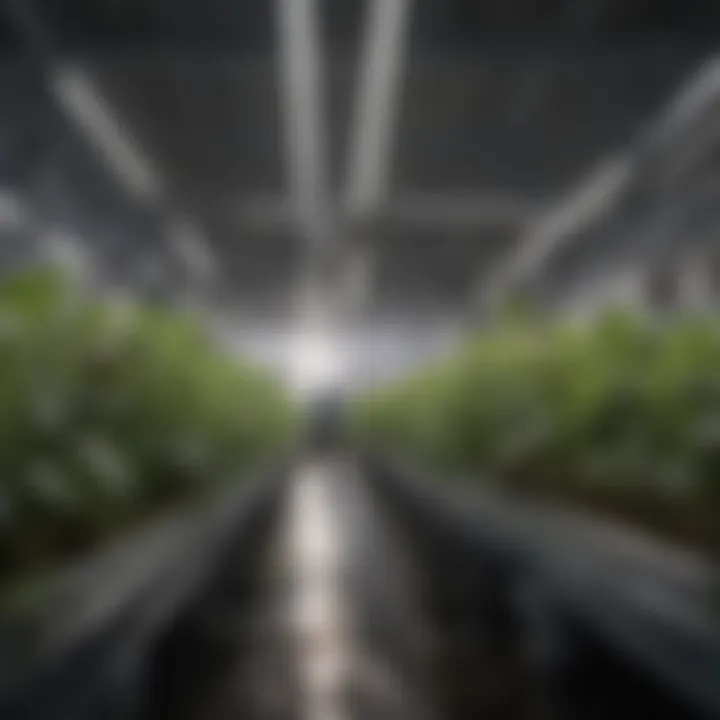Optimal Hydroponic Crops: A Comprehensive Guide


Intro
Hydroponics represents a revolutionary approach to agriculture. It allows for the growth of plants without soil, utilizing nutrient-rich water instead. As urbanization increases, traditional farming faces challenges, such as space limitations and declining soil health. Hydroponics offers a potential solution, creating opportunities for efficient and sustainable food production.
In this guide, we will explore the wide array of crops that thrive in hydroponic systems. Our focus is on specific growth characteristics, essential nutrient requirements, and the significance of light exposure. Understanding these factors is crucial for maximizing yields and ensuring the successful cultivation of plants in hydroponic environments. We will also provide insights into various hydroponic systems and their benefits. This comprehensive look into hydroponic crops will serve both novices and seasoned growers, aiding them in making informed decisions on what to cultivate in their gardens.
Foreword to Hydroponics
Hydroponics is an innovative method of growing plants without soil, using nutrient-rich water instead. This technique is becoming increasingly significant as urbanization and population growth put pressure on traditional farming methods. It allows for greater control over growing conditions, leading to more efficient use of resources and higher crop yields.
This article will delve into the specifics of hydroponic gardening, highlighting the optimal crops suitable for various systems. Understanding the fundamentals of hydroponics is crucial for anyone interested in maximizing their agricultural output.
Definition and Overview
Hydroponics can be defined as a method of growing plants where the primary medium is a nutrient solution, rather than soil. The technique allows for the direct delivery of nutrients to the plant's roots. This system can be implemented indoors, minimizing the impact of adverse weather, pests, and diseases that affect traditional farming.
There are various hydroponic systems, including Deep Water Culture and Nutrient Film Technique, each with its unique advantages. By eliminating soil, growers can reduce the time it takes for plants to mature and increase the frequency of harvests. Key components in any hydroponic system include water quality, nutrient management, and environmental controls.
The Importance of Crop Selection
Selecting the right crops for hydroponic systems is critical for success. Unlike traditional agriculture, hydroponics allows for the cultivation of a wide variety of plants, but not all are equally suited for these methods.
Factors to consider include:
- Growth Rate: Fast-growing crops, like leafy greens, are ideal for beginners, as they allow quicker turnaround between planting and harvesting.
- Market Demand: Growing herbs or fruit-bearing plants requires consideration of consumer preferences and market trends.
- Space Efficiency: Certain crops can be grown in vertical systems, utilizing space more effectively.
- Nutrient Needs: Different plants have varying requirements for nutrients, which can impact management strategies.
Selecting the appropriate crops is not just about yield but also about enhancing overall satisfaction for the grower and consumer.
"In hydroponics, the potential for customization regarding crop selection provides a distinct advantage over traditional methods, and it enhances sustainability."
Ultimately, understanding how to effectively choose crops for hydroponic systems plays a vital role in the productivity and efficiency of any urban agricultural venture.
Categories of Hydroponic Crops
Understanding the categories of hydroponic crops is essential for anyone interested in optimizing their hydroponic garden. The selection of the right crops can significantly influence the yield, nutrient uptake, and overall success of the hydroponic system. Each category of plants has unique requirements, and knowing these is important for any grower, whether novice or experienced.
The main categories covered in this guide include leafy greens, herbs, fruit-bearing plants, and root vegetables. The benefits of understanding these categories are numerous. They range from easier management of growing conditions to improved access to market demands. Specific crops address particular culinary needs and dietary trends, making informed selection crucial.
Leafy Greens
Leafy greens are perhaps the most popular category in hydroponics. Crops such as lettuce, spinach, and kale thrive in this system, offering numerous advantages.
Lettuce Varieties
Lettuce is a staple in many hydroponic systems. This plant grows quickly, offering fast returns on investment. Multiple varieties, including romaine, butterhead, and crispy lettuces, cater to diverse consumer preferences. A key characteristic of lettuce is its shallow root system, which allows it to utilize the nutrient-rich water efficiently.
One unique feature of lettuce is its ability to grow densely in small spaces. This makes it an excellent choice for urban farmers with limited room. However, lettuce is sensitive to temperature changes, and environmental control is vital to prevent bitterness in the leaves.
Spinach
Spinach is another robust option for hydroponic growers. It is rich in nutrients and several varieties exist, each adaptable to hydroponic conditions. Spinach's key characteristic is its high yield potential; it can be harvested multiple times from a single plant.
Moreover, spinach grows well in various systems, adding to its appeal. The unique feature of spinach is its tolerance to cooler temperatures, allowing it to thrive when other crops may struggle. One disadvantage is its susceptibility to diseases like downy mildew, which requires careful monitoring.
Kale
Kale is a highly sought-after leafy green, known for its health benefits and culinary versatility. Its ability to grow well in hydroponic systems makes it a valuable crop. Its key characteristic is hardiness, allowing it to withstand lower light conditions.
Kale, being a nutrient-dense food, caters to health-conscious consumers. Its unique feature is that it can be harvested continuously, promoting sustained yield. However, kale has a slower growth rate compared to other leafy greens, which might impact overall productivity.
Herbs
Herbs add unique flavors to various dishes and are easy to cultivate in hydroponic systems. Common choices include basil, mint, and cilantro.
Basil
Basil is a favorite among chefs and home cooks alike. It's relatively simple to grow and should be considered due to its fast growth and high market demand. A key characteristic of basil is its preference for warmer temperatures and high humidity.
Basil can produce significant yields in hydroponic setups, satisfying culinary needs. Its unique feature is the aromatic properties that enhance the flavor of dishes. However, basil requires frequent pruning to maintain its quality, which could be challenging for beginners.
Mint
Mint is another herb that thrives in hydroponic systems. It is notable for its strong aroma and flavor. The key characteristic of mint is its rapid growth, contributing to a bountiful harvest.


Its unique feature is a tendency to spread quickly, which may require careful management. This can be a double-edged sword; while it increases yield, it can also take space from other plants if not controlled.
Cilantro
Cilantro is a commonly used herb in various cuisines, making it a popular choice for growers. Its key characteristic is that it is a fast-growing plant with a relatively short growth cycle.
A unique feature of cilantro is its leaf structure; the different stages of growth offer distinct culinary applications. While cilantro's quick maturity is beneficial, it can bolt (flower) rapidly in warm conditions, limiting its growing period.
Fruit-bearing Plants
Fruit-bearing crops are more complex to manage but offer rewarding harvests. Tomatoes, strawberries, and cucumbers are ideal examples.
Tomatoes
Tomatoes are favored for both commercial and personal gardens. Their adaptability to hydroponic systems is noteworthy. The key characteristic of tomatoes is their requirement for support as they grow.
Tomatoes produce high yields but need consistent moisture and nutrient supply. A unique feature is their sensitivity to light levels; too little can stunt growth, while too much can cause sunscald. Proper training and pruning are necessary to manage their growth.
Strawberries
Strawberries are a delicate yet profitable option for hydroponics. Their growth requires specific care, particularly concerning temperature and pH levels. The key characteristic of strawberries is their need for pollination, which can require additional effort.
A unique feature is that strawberries can be grown in vertical systems, maximizing space. This could be a challenge as they require more attention to prevent mold and pests.
Cucumbers
Cucumbers are relatively easy to grow Hydrponically. They thrive with consistent watering and generous light. Their key characteristic is that they produce fruit quickly, appealing to those looking for fast yields.
A unique feature of cucumbers is their climbing ability, which helps in space conservation. However, they can be susceptible to powdery mildew, necessitating careful environmental control.
Root Vegetables
Root vegetables such as radishes, carrots, and beets require thoughtful consideration in hydroponic systems. Their soil requirements differ from traditional cultivation methods.
Radishes
Radishes are among the quickest root crops to grow in hydroponics. They mature in just a few weeks, which makes them appealing. Their key characteristic is their robust growth even in tight spaces.
Radishes also offer quick turnover, boosting productivity. However, their unique feature is the specific nutrient requirements that need to be monitored closely to ensure proper root development.
Carrots
Carrots face unique challenges when grown hydroponically. They require deeper systems to accommodate their long roots. The key characteristic of carrots is their demand for consistent moisture throughout the growth cycle.
A unique feature of the carrot is its slow growth compared to other vegetables. This can pose risks, such as pest infestations during extended cultivation periods.
Beets
Beets are nutrient-rich and can thrive in hydroponic settings. Their key characteristic is their ability to store sugars, which enhances their flavor when grown in optimal conditions.
Beets can be harvested in multiple phases, giving growers flexibility. However, their unique feature is the distinct way they can be affected by high nitrate levels, which can impact their sweetness.
Key Factors for Successful Hydroponics
Hydroponic cultivation offers an innovative way to grow plants without soil, but success is heavily dependent on key factors. Understanding and managing these elements is vital for optimizing plant growth and yield. Each component plays a role in the health of plants and the efficiency of the hydroponic system. This section delves into the critical factors necessary for successful hydroponic gardening.
Nutrient Management
Nutrient management is a cornerstone of hydroponic farming. Plants require essential nutrients to thrive, and in a soil-less environment, delivering these nutrients accurately is crucial.
Types of Nutrients
Nutrients can be categorized into two main types: macronutrients and micronutrients. Macronutrients, such as nitrogen, phosphorus, and potassium, are required in larger quantities for optimal growth. Micronutrients, including iron, zinc, and manganese, are needed in smaller amounts but are equally essential. Finding the right balance among these nutrients benefits plant health and growth rates.
One unique feature of nutrient management in hydroponics is the ability to tailor nutrient solutions to specific plant requirements. This customization leads to healthier plants and potentially higher yields because growers can adjust the nutrient mix based on plant growth stages.
Nutrient Delivery Methods
There are several delivery methods for nutrients in hydroponic systems. The most popular methods include deep water culture, nutrient film technique, and aeroponics. Each of these systems provides nutrients differently, impacting how easily plants can absorb them.
Deep water culture allows plant roots to sit in a nutrient-rich solution, while nutrient film technique circulates a thin film of nutrients over the roots. Aeroponics involves misting the roots, providing moisture and nutrients directly. Each method has its own strengths and weaknesses, and it is essential to choose one that aligns with both the type of crops being grown and the grower's expertise.
Light Requirements


Light is another critical factor influencing the health and productivity of hydroponic crops. Proper light conditions ensure that plants perform photosynthesis efficiently, leading to growth and strong yields.
Natural Light
Natural light is often the most desirable option for hydroponic gardens, as it provides a full spectrum necessary for photosynthesis. The sun's light intensity and duration, however, can vary with seasons and geographic locations.
A major advantage of using natural light is that it is free and can significantly lower energy costs in the long term. However, if proper light levels are not consistent, plants may not flourish. This variability poses challenges during less sunny months or for those growing indoors without adequate windows.
Artificial Light Sources
Artificial light sources, such as LED grow lights or fluorescent lights, are frequently utilized to supplement or replace natural light. One of the primary benefits of artificial light is the ability to control spectrums and intensity, which is crucial for optimizing growth rates.
Artificial lights shine best in controlled environments. But they also consume energy, leading to increased operational costs. Selecting efficient lighting can mitigate some of those costs.
Water Quality
Water quality is critical for hydroponic systems since it transports nutrients to the plants. Factors like pH level and electrical conductivity (EC) can greatly influence plant growth.
pH Levels
Maintaining proper pH levels is vital for nutrient absorption. Most hydroponic crops thrive in a pH range of 5.5 to 6.5. When pH levels deviate from this range, plants may struggle to absorb nutrients effectively.
A unique advantage of managing pH levels in hydroponics is the quick adjustments possible compared to traditional soil gardening. Regular monitoring and adjustments can ensure that nutrients remain bioavailable. However, consistently checking and calibrating pH instruments can add maintenance pressure.
EC Measurement
Electrical conductivity measures the amount of dissolved salts in the water, indicating nutrient concentration. Managing EC levels ensures that plants receive the correct amount of nutrients.
Regular EC measurement allows growers to maintain optimal nutrient levels, making it a crucial aspect of nutrient management. However, high EC levels can be detrimental. They may cause nutrient lockout, leading to deficiencies and plant stress.
System Types
Choosing the right hydroponic system is key to productivity. Different systems offer various methods for managing plant growth, water, and nutrients.
Deep Water Culture
In deep water culture, plant roots are submerged in nutrient-rich, oxygenated water. This system is relatively simple and cost-effective for beginners.
A significant advantage is the high growth rate due to constant nutrient contact with the roots. However, a downside may be oxygen depletion if the oxygenation system fails.
Nutrient Film Technique
The nutrient film technique involves a thin film of nutrient solution flowing over the roots of plants. This method is known for efficient nutrient use and fast growth.
However, it requires precise system maintenance and monitoring. A blockage or pump failure could lead to rapid plant stress or loss.
Aeroponics
Aeroponics is a high-tech system that uses mist to provide water and nutrients. This method maximizes oxygen exposure to roots, promoting rapid growth levels.
While aeroponics can offer exceptional growth rates, it often requires a high level of technical knowledge and careful management of the misting system and nutrient solution.
Successful hydroponics relies on integrating these key factors - nutrient management, light requirements, water quality, and system types. By understanding and effectively managing these elements, growers can expect better crops and yields.
Challenges in Hydroponic Crop Growth
Growing crops hydroponically brings several advantages but also presents unique challenges. Successful hydroponic cultivation demands an understanding of how to manage these challenges effectively. The health of crops directly impacts yield and quality. Addressing issues like pest management, diseases, and environmental control is critical to achieving optimal results. Understanding these challenges equips growers with strategies to mitigate risks and foster healthy plants in a controlled environment.
Pest Management
Common Hydroponic Pests
Common hydroponic pests disrupt plant growth and can significantly affect yields. Common pests include aphids, whiteflies, and spider mites. They thrive in the warm, humid environments typical of hydroponic systems. Understanding these pests is essential to protect crops effectively.
In hydroponic systems, pests often spread rapidly due to the proximity of plants. They can cause considerable damage if not managed promptly. Utilizing integrated pest management techniques can help in recognizing and controlling these pests effectively. However, the challenge is to find methods that do not disrupt the delicate balance of the hydroponic ecosystem, which makes it tricky yet essential.
Integrated Pest Management Techniques
Integrated Pest Management (IPM) emphasizes a holistic approach to pest control. This strategy involves monitoring pest populations, using biological controls, and applying chemical controls judiciously. It reduces reliance on chemical pesticides, making it a suitable choice for many hydroponic growers.
By integrating several strategies, growers can minimize pest impact while maintaining crop health. IPM contributes to the overall sustainability of hydroponic systems. However, its implementation requires careful planning and consistent monitoring of pest populations to be effective. Understanding these techniques is beneficial for sustainable crop management in hydroponics.
Diseases


Identifying Symptoms
Identifying symptoms of diseases in hydroponic crops is crucial for early intervention. Common symptoms can include yellowing leaves, wilting, or stunted growth. Early detection plays a key role in preventing widespread damage. Understanding these symptoms can guide growers in taking timely actions to protect their crops.
Recognizing these symptoms early can make a lot of difference. It allows for adjustments in nutrient management or environmental conditions before the disease spreads. However, symptom identification requires careful observation and experience.
Preventive Measures
Preventive measures focus on maintaining the health of hydroponic crops and reducing disease risk. Good practices include ensuring proper sanitation, controlling humidity, and monitoring nutrient levels. These measures can significantly decrease the likelihood of diseases developing.
Preventive actions can include crop rotation and using disease-resistant crop varieties. These approaches are especially beneficial as they can reduce disease pressure without relying heavily on chemical treatments. However, preventive measures require ongoing attention and commitment from growers.
Environmental Control
Temperature Regulation
Temperature regulation stands as a fundamental aspect of successful hydroponic growth. Maintaining optimal temperatures can enhance plant growth and maximize yields. Each crop has a preferred temperature range, and deviations can lead to reduced growth or even plant death.
Efficient temperature control systems, such as fans and heaters, can help mitigate drastic temperature fluctuations. Investing in these systems can promote a stable growing environment. Nonetheless, managing temperature requires careful monitoring to balance energy use and plant health.
Humidity Control
Humidity control is equally important to prevent diseases and promote healthy plant growth. Optimal humidity levels can support strong root systems and healthy foliage. High humidity can encourage mold and mildew, while low humidity can lead to water stress.
Systems like dehumidifiers can assist in maintaining appropriate humidity levels. However, controlling humidity requires precise adjustments and attention throughout the growth cycle. Achieving the right balance is crucial for optimizing crop growth in hydroponics.
Future of Hydroponic Agriculture
The landscape of agriculture is shifting, and hydroponics stands at the forefront of this evolution. Understanding the future of hydroponic agriculture requires a deep dive into technological advancements and sustainability considerations. Both aspects are crucial for optimizing hydroponic systems and ensuring their viability for years to come.
Technological Advancements
Automated Systems
Automated systems in hydroponic agriculture have revolutionized how crops are grown. These systems reduce the need for constant human oversight and allow for precise control over environmental factors such as nutrient delivery, pH levels, and water flow. A key characteristic of automated systems is their ability to integrate various technologies such as sensors and software for real-time monitoring. This approach is popular because it increases efficiency and helps to prevent human error in hydroponic management.
A unique feature of automated systems is their accessibility to growers of all experience levels. While initial setup costs can be high, their long-term benefits outweigh the disadvantages. For instance, less manual labor is required, freeing up time for growers to focus on other aspects of cultivation.
Data Monitoring
Data monitoring plays a pivotal role in the future of hydroponic farming. This aspect utilizes various sensors to track critical parameters like nutrient concentration, temperature, and humidity. The key characteristic of data monitoring is its real-time feedback capability, which allows farmers to make quick adjustments to their systems. This responsiveness is especially beneficial in maintaining optimal growing conditions that significantly boost crop yields.
A unique feature of data monitoring is its potential for predictive analytics. By analyzing trends and patterns, growers can anticipate problems before they escalate. However, the downside can be the complexity and initial learning curve associated with these technologies, which may deter some. Nonetheless, the benefits of enhanced crop management via data monitoring are clear.
Sustainability Considerations
Resource Efficiency
Resource efficiency is essential in assessing the future of hydroponic agriculture. This concept emphasizes minimizing the use of water, nutrients, and energy. The key characteristic here is the closed-loop systems that hydroponics can achieve, significantly reducing waste compared to traditional farming. This has become a popular choice among forward-thinking growers, particularly in regions with limited natural resources.
A unique feature of resource efficiency in hydroponics is the ability to recycle water and nutrients. Such systems contribute to sustainability by lowering the overall demand on environmental resources. However, initial investments in efficient systems might be considerable, which can be a barrier to entry for some. Still, the long-term sustainability gains speak volumes about its worth.
Reducing Carbon Footprint
Reducing carbon footprint is another major consideration for the future of hydroponic agriculture. The modern techniques employed in hydroponics allow for growing crops closer to urban centers, thereby decreasing transportation emissions associated with traditional agriculture. A critical characteristic of this approach is the reduction of land-use change, which contributes to a more sustainable food production system.
An important unique feature of reducing carbon footprint in hydroponics is its alignment with urban agriculture goals. This integration promotes local food production, enhances food security, and directly addresses climate change concerns. On the flip side, growers must still consider the carbon footprint of the energy sources used for lighting and climate control. The importance of renewable energy in this context cannot be overstated, as it can further enhance the benefits of urban and sustainable agriculture.
"The future of hydroponic agriculture is not just about growing food; it’s about doing so in a way that respects the planet and its resources."
Approaching the future of hydroponic agriculture with an emphasis on these advancements and considerations equips growers to innovate and cultivate effectively. Navigating these complexities will ensure that hydroponics remains a vital part of sustainable agricultural practices.
The End
The conclusion of this article serves as a vital summary of the key points related to hydroponic crop selection and cultivation. It reinforces the importance of understanding which crops are best suited for hydroponic systems, ultimately influencing the success of any hydroponic garden. Hydroponics offers unique advantages, such as water efficiency, space saving, and fewer pests. Choosing the right crops optimizes growth and yield.
In this guide, we explored various categories of hydroponic crops including leafy greens, herbs, fruit-bearing plants, and root vegetables. Each category comes with its own set of requirements and benefits. For instance, leafy greens thrive well in nutrient solution and shorter growth cycles, while fruits may require more careful nutrient management and light exposure to maximize yields.
The challenges discussed earlier—pest management, diseases, and environmental control—also influence crop choice. Understanding these factors will help growers anticipate potential issues and adapt accordingly.
Overall, it is evident that selecting the right crop matters significantly in hydroponics. This selection, when combined with the proper techniques, can lead to successful crop production and sustainable gardening practices.
Recap of Key Points
- The diversity of crops suitable for hydroponics is vast, encompassing leafy greens, herbs, fruits, and root vegetables.
- Each crop requires specific nutrients, light, and water conditions for optimal growth.
- Various systems such as Deep Water Culture and Nutrient Film Technique offer different benefits, catering to different crop needs.
- Challenges like pests and diseases must be addressed through informed pest management and preventive measures.
- Future advancements in hydroponics hint at a sustainable agricultural pathway that maximizes resource efficiency.
Encouragement for Further Exploration
Hydroponics is not just a method for growing plants; it is a pathway to understanding sustainable agriculture and modern farming techniques. As technology evolves, new methods emerge that allow for even greater crop yields and efficiency. Growers should be open to experimenting with different systems and crops to find the optimal combination that works for their specific situations.
Additionally, participating in forums and communities can lead to valuable insights and shared experiences. Websites such as Wikipedia, Britannica, and even social platforms like Reddit foster discussion and knowledge sharing.



